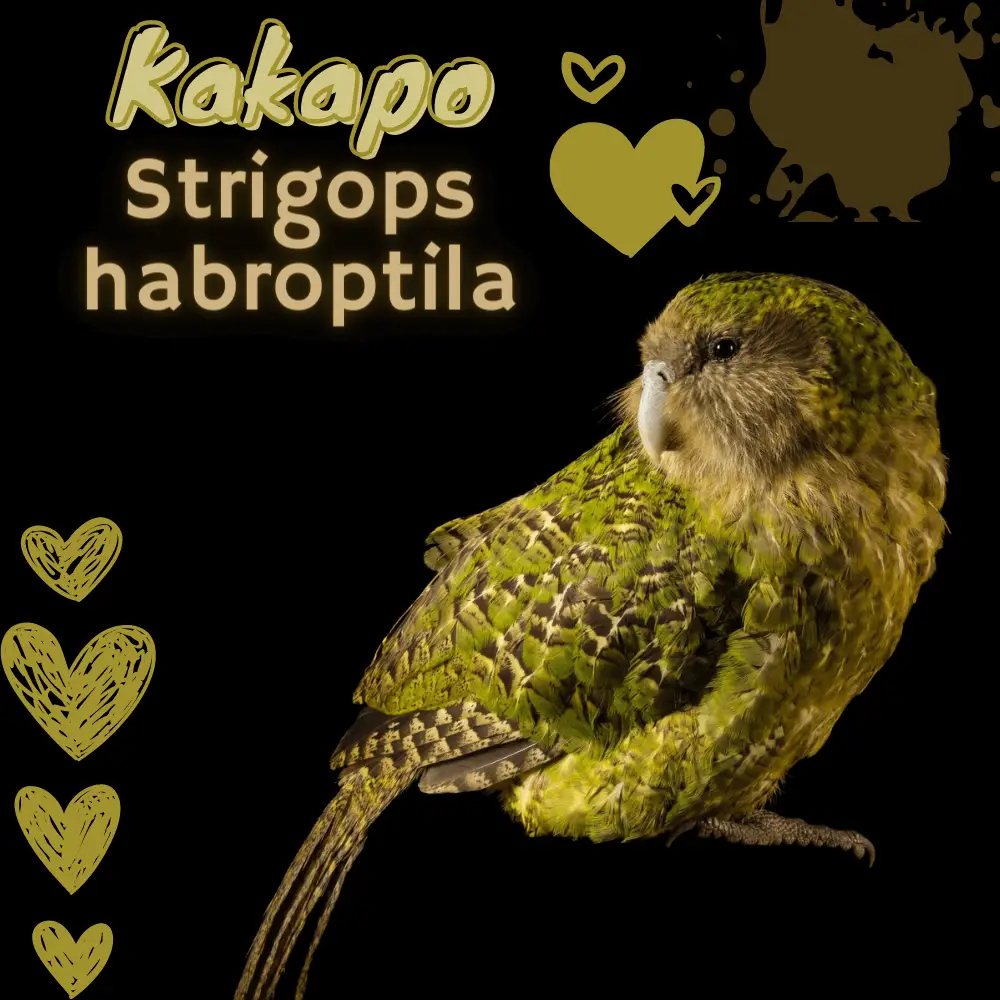
Kakapo (Strigops habroptila) 64 cm; 950–3000 g. Green above, mottled with blackish chevrons and brownish blotches, tail patterned greenish-yellow, brown and black;
yellowish below, with notches and bars of buff and green; superciliary stripe lemon yellow; forehead, face and ear-coverts yellowish-brown with elongate rictal bristles. Female no different in size but less heavy. Immature duller, face browner.
- CR Critically Endangered
- Names (15)
- Monotypic
Systematics History
The specific epithet was originally given in the masculine form, but the genus was formally declared to be feminine by ICZN Direction 26 of Nov 1955. Monotypic.
Subspecies
Monotypic.
Can Kakapo Fly
SOURCE: BBC Earth
New Zealand, formerly on North I, South I, and Stewart I (claimed subfossil remains from Chatham Is considered erroneous ); persisted until 1927 on North I (Huiarau Range), until 1987 on South I (Milford District of Fiordland), and until 1997 on SE Stewart I.
Now survives as translocated populations on Codfish I (off Stewart I), Anchor I and Chalky I (Fiordland, SW South I), and possibly still Maud I (NE South I); recently reintroduced to Little Barrier I (N North I).
Kakapo Flying
SOURCE: BBC
Kakapo Habitat
Primarily mossy Nothofagus forests, particularly where adjacent to open ground along river flats or the subalpine scrub belt bordering snow tussock Danthonia meadows. Birds shelter by day in low trees, rock crevices, burrows amidst roots or under shrubs, becoming active at night.
Movement
Sedentary (flightless).

where do kakapo live
Kakapo Diet
Versatile and opportunistic vegetarians with different seasonal diets: fruits, berries, nuts, seeds, green shoots, leaf buds, roots, rhizomes, tubers, bark, stems, moss, fungi.
On Stewart I main food plants are Blechnum fern fronds, followed by Dracophyllum, Gahnia, and Astelia, plus Lycopodium, Schizaea, Cyathodes, Olearia, Thelymitra, Oreobolus, and Carex,
with new growth and developing foliage targeted in spring and summer, and subterranean parts of plants from autumn through to early spring;
the fruit of Fuchsia was reportedly important, and the crops of some birds were filled with moss. The absence of reproductive behavior in certain years is linked to the erratic availability of certain food, once thought to be tussock and grass seed, but apparently (on Stewart I and CodfishI) autumn mast production of podocarps.
Even chicks in the first weeks of life are not fed animal food, but Agathis australis leaves apparently important and fruits and leaves of rimu (Dacrydium cupressinum).
Kakapo Sound
Males kakapo parrot produce a booming sound at night which may continue for hours, a single or double low-pitched hoot (< 100 Hz) repeated every few seconds, sometimes alternated with a series of repeated short wheezing screeches (so-called “chinging”), to attract potential mates to their leks.
Both sexes utter a loud high-pitched “streak” call, and furthermore, a variety of squeals, shrieks, growls, and croaks have been reported.
Kakapo Breeding
Dec–Feb, once as late as May. Birds form no pair-bond and males lek vocally to attract females at night, but in some years all activity is suspended. The nest is a burrow in the large crevice between rocks or tree roots.
Eggs 1–2, rarely 3, evidently with long intervals between the laying of first and second eggs; incubation c. 30 days; nestling period c. 3½ months. Females have been known to breed at 9 and 11 years old, but may be able to do so earlier.
Kakapo Endangered
Conservation status on BirdlifeCR Critically Endangered
CRITICALLY ENDANGERED. CITES I. Formerly occurred throughout New Zealand’s North and South Is and Stewart I from sea level to alpine regions.
Its range contracted substantially following the first human (Maori) occupation of New Zealand c. 1200 years ago; Kakapo was hunted as food and to make clothing, but the burning of habitat, hunting by dogs (Canis domesticus), and especially predation by introduced Polynesian rats (Rattus exulans) indirectly hastened its demise.
In steady retreat since then, it appears to have begun its catastrophic decline when European settlement resulted in the establishment of alien predators, notably the stoat (Mustela erminea) and black rat (R. Rattus),
although on Stewart I the principal cause of the decline was feral cats, and it is now judged that Polynesian rats are serious threats to nesting birds.
Some of its biological traits, such as the males’ habit of clustering at leks and the five-month-long involvement of females in ground-nesting, have made it vulnerable to predation.
The last accepted North I record was in 1927, last South I record (three males in Fiordland) in 1987. Stewart I population of 100–200 birds was only discovered in 1977, and judged to be rapidly declining, mainly due to predation by introduced cats (Felis silvestris catus); the absence of mustelids probably spared this population from extinction.
Between 1980 and 1997 all 62 remaining birds on Stewart I was translocated to the predator-free islands of Codfish, Maud, and Mana (failing to establish on Mana), so that with a population already transferred to Little Barrier I the species is now extinct throughout its natural range.
Intensive management of each individual kakapo and nest at the new sites has allowed the Kakapo to make a gradual comeback.
By 2005, Kakapo parrot populations occupied four islands – Codfish, Chalky, Anchor, and Maud– and numbered 86 birds, of which 52 were breeding adults (21 females and 31 males). After a favorable breeding season, this increased to 124 birds in 2009.
Shagged by a rare parrot | Last Chance To See – BBC
SOURCE: BBC




















